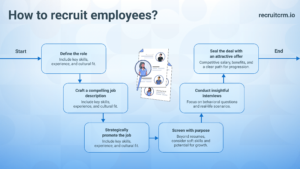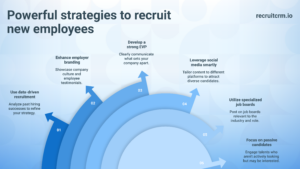Struggling to recruit quality talent for your business?
Here’s a list of practical strategies and detailed steps for streamlining your recruitment process and securing the best candidates. Read on!
Why is effective recruitment so important?

The backbone of an organization’s success lies in its people, and effective recruitment is the first step in sourcing this talent. Let’s delve into why this process holds such monumental significance:
1. Identifying the best talent
A robust recruitment process starts with a precise role definition, followed by diverse candidate sourcing, diligent screening, and comprehensive interviewing.
It may also encompass role-specific assessments, and thorough reference checks and ends with a fair offer and thoughtful onboarding, thereby securing top-tier talent that resonates with the company’s vision and culture.
2. Building a competitive edge
In today’s fast-paced business landscape, you’re not just competing based on the company’s products or services but also the talent powering the organization.
Recruiting top-notch individuals effectively boosts an organization’s productivity and output quality, placing it ahead in the corporate race.
3. Enhancing company culture
Through effective recruitment, you are selecting individuals who resonate with a company’s values and spirit. This way, you are creating a harmonious and conducive work environment, which in turn fuels employee satisfaction and retention.
How to recruit employees? 7 seamless steps

Step 1: Understanding your needs
To attract the right job applications, you first need to identify what ‘right’ looks like for your company. This involves outlining the skills, experience, and personality traits required for each job role in line with the company’s vision, culture, and business goals.
Develop comprehensive job descriptions and role profiles, clearly defining the responsibilities, required skills, and expectations.
This clarity not only gives potential candidates an accurate impression of the role but also serves as a benchmark to screen applications and assess candidates effectively.
Step 2: Building a strong employer brand
Today, potential candidates evaluate more than just salary and open positions; they assess a company’s reputation as an employer.
A study by LinkedIn found that 75% of job seekers research about a company’s brand before applying. Crafting a strong employer brand involves articulating the company’s values, mission, and culture in a way that resonates with potential candidates.
This can be achieved through various channels, including the company’s website, social media platforms, and even its current employees, who can be influential brand ambassadors.
Step 3: Sourcing candidates
Sourcing candidates involves various strategies, like advertising on job boards, leveraging professional networks, and even tapping into the talent of existing employees through referrals.
An efficient sourcing strategy doesn’t only reduce the time-to-hire but also ensures a high-quality, diverse candidate pool, thereby increasing your chances of finding the perfect fit for your client
Pro tip: Use #RecTech in sourcing – Recruitment technology can significantly enhance the efficiency and effectiveness of your hiring process. Automating mundane tasks like job postings and resume screening through an applicant tracking system (ATS) can save valuable time.
Step 4: Optimizing the application process
The application process is the first tangible interaction between a potential employee and you. If it’s long-winded and complicated, you risk losing out on the best candidates.
So ensure your application process is simple, uncomplicated, and mobile friendly, because nearly 58% of job seekers use their mobile devices for job hunting.
Step 5: Interviewing and assessing candidates
Implement a structured job interview process that uses a mix of behavioral and competency-based questions to assess how a candidate would perform in the role.
Consider using assessment tools, such as personality and aptitude tests, to get a well-rounded view of each candidate.
Also, don’t overlook cultural fit—an employee who doesn’t mesh with your company’s culture can be disruptive and negatively impact morale.
Step 6: Sending out offer letters
Once you’ve identified the perfect candidate for your role, it’s time to make it official with an offer letter.
Start by crafting a well-structured offer letter that clearly outlines the job responsibilities, salary, benefits, start date, and other pertinent details. This transparency not only sets clear expectations but also helps to build trust with your new hire from the outset.
Remember, the offer letter is also a reflection of your client’s brand. So, ensure it’s professionally written and aligns with their company’s tone and style.
Step 7: Onboarding new employees successfully
Successful employee onboarding is crucial for integrating new employees into your company.
Begin by preparing their workspace and access to necessary tools and information before their first day. Create a structured orientation program that includes meetings with key team members and an overview of company policies, culture, and expectations.
Assign a mentor or buddy for the first few weeks to help them acclimate and address any questions. Regular check-ins during the first few months are essential to ensure they feel supported and to gauge their progress and engagement.
Also, emphasize communication and feedback to make this transition smooth, fostering a sense of belonging and contribution from the start.
10 powerful strategies to recruit new employees

1. Using job boards and career sites
Job boards and career page provide a platform for recruiters and employers to reach a vast audience of job seekers.
By strategically using these platforms, you can showcase the company’s employer brand and attract candidates from diverse backgrounds and locations. Make your job ads stand out by focusing on the opportunities and benefits the business provides.
Use all kinds of platforms to reach a wide audience and attract candidates from various backgrounds and locations. Don’t just list the job requirements—make your postings compelling by focusing on the benefits the company offers and the opportunities for growth it provides.
2. Leveraging social media platforms
Social recruiting has become very popular among headhunters. Social media platforms are a space where you can engage with potential candidates, answer their questions, and showcase company culture.
Plus, you can leverage your and your client’s employees’ networks to reach more potential candidates. Remember to keep your company’s social media profiles updated and engaging—these platforms are an extension of its employer brand.
3. Implementing employee referral programs
Your client’s current employees can be some of your best recruiters. They understand their company’s culture and the type of people who thrive in it.
Discuss with your client and implement an employee referral program to encourage these employees to refer candidates from their networks.
Ensure there are proper incentives or bonus rewards to the employees, making them feel appreciated for their contributions to the company. Plus, referred candidates are often a better cultural fit and faster to hire.
4. Conducting job fairs and local events
Job fairs and local events provide a platform for personal interaction with potential new hires.
They give you the chance to give a human face to the organization you’re hiring for, answer queries in real-time, and make a lasting impression on potential applicants and hiring managers.
Make sure your representatives are well-prepared to answer questions and provide information about the company and available positions. Virtual job fairs can also be beneficial, especially in a world that is becoming more focused on remote hiring.
5. Leveraging internship programs
During internship periods, you can observe how well an intern integrates into the team, adapts to the company culture, and handles real-world tasks related to their field of study.
Their problem-solving abilities, creativity, and capacity to learn and grow within the work environment can be assessed without the pressure of permanent employment.
It’s almost like having a prolonged interview process that also contributes to the company’s projects and tasks.
On the flip side, internships offer candidates invaluable practical experience in their chosen industry. Unlike traditional recruitment processes, internships enable individuals to get a taste of the actual work involved in their role, the company’s environment, and the industry’s demands.
It’s a hands-on opportunity for them to apply theoretical knowledge, develop new skills, and understand their career preferences better.
6. Building and promoting a strong employer branding
Highlighting aspects like inclusive culture, career development opportunities, flexible working conditions, and employee benefits can make an organization an attractive place to work.
Ensure that your client’s employer branding efforts are consistent across all platforms—be it their company’s website, social media profiles, job postings, or even their office environment.
7. Using a recruitment software
In today’s digital age, there’s an array of recruitment software available that can do wonders in automating and streamlining your employee recruitment process.
For instance, an applicant tracking system is an incredible tool that helps manage job postings, track applications, and streamline communications. It acts as a centralized database where you can store and organize all candidate information, making it accessible for easy referencing.
But that’s not all! Candidate relationship management systems (CRMs) take it further by nurturing potential candidates even before a relevant vacancy arises.
CRMs allow you to engage with candidates, send them personalized emails, and keep them warm for future opportunities.
Pro tip: Invest in a recruiting software that is both an ATS + CRM system. The best on the market is Recruit CRM. Book a demo with them to see their platform in action!
8. Creating an inclusive and diverse hiring process
Organizations that champion diversity are likely to be more innovative and financially successful. A diverse workforce brings a varied range of perspectives, ideas, and experiences that can enhance problem-solving and decision-making.
Ensure you adopt diversity hiring by using inclusive language in job descriptions, offering flexible working options, and training your recruitment team to avoid unconscious biases.
9. Crafting compelling job descriptions
A compelling job description does more than just outline the duties of a position. It sells the position to potential candidates, highlighting the opportunities for growth, the perks and benefits, and the exciting aspects of the job.
The description should be clear and concise, stating the required qualifications, skills, and experiences. But, don’t forget to infuse it with the company’s personality to attract like-minded individuals who align with its culture.
Remember to include a proper job title at the beginning of the document.
10. Promoting from within
Internal recruitment can be a highly effective strategy. It boosts morale, improves retention, and can be more cost-effective than external hiring.
Encourage employee development and ensure your client’s employees know about job openings within the company. You might be surprised at the talent already in your ranks.
According to a recent report by LinkedIn, internal hires tend to perform better in their new roles than external hires as they have in-built skill sets for the open roles.
Successful recruitment isn’t a cookie-cutter process where one strategy fits all. It’s a complex and dynamic jigsaw puzzle, requiring a careful blend of different tactics tailored to your unique organizational needs.
So, start this recruitment journey with your eyes open and tools ready and let the steps outlined in this guide serve as your roadmap.
Sample recruiting email templates for hiring quality employees
1. Initial contact
Template 1: Cold outreach to potential candidate
Subject: Explore new horizons with [Company_name]
Dear [Candidate’s_name],
I’m [Your_name], and I specialize in talent acquisition at [Company_name]. Your experience with [Specific_skill_or_project] caught our eye. We are always in search of exceptional new talent who are eager to make an impact, and your background appears to be a great fit for our team.
Would you be open to a brief chat about your career aspirations and how they might align with opportunities at [Company_name]? Please let me know your availability for a conversation.
Warm regards,
[Your_name]
Template 2: Acknowledgment of application
Subject: Thank you for applying to [Position_name]
Dear [Candidate’s_name],
Thank you for your interest in the [Position_name] with [Company_name]. We are currently reviewing your application among other candidates. You can expect to hear back regarding the next steps within [Time_frame].
We appreciate your interest in joining our team!
Best,
[Your_name]
2. Interview process
Template 1: Interview invitation
Subject: Invitation to interview for [Position_name] at [Company_name]
Dear [Candidate’s_name],
After reviewing your application, we are excited to move forward in the interview process for the [Position_name] position.
We’d like to invite you for an interview to discuss your background, the role, and how you can contribute to [Company_name].
Please let us know your availability for a [virtual/in-person] interview on one of the following dates: [Insert_dates].
Looking forward to our conversation.
Best,
[Your_name]
Template 2: Interview reminder
Subject: Reminder: Upcoming interview for [Position_name]
Dear [Candidate’s_name],
This is a gentle reminder about your upcoming interview for the [Position_name] position at [Company_name] on [Date_and_time]. The interview will be conducted via [Platform/Location] with [Interviewer’s_name].
Please feel free to reach out if you have any questions or need further information before our meeting!
Best regards,
[Your_name]
3. Job offer
Template 1: Job offer
Subject: [Company_name] job offer – [Position_name]
Dear [Candidate’s_name],
We are pleased to extend an offer to you for the position of [Position_name] with [Company_name]. We were impressed with your background and believe your experience will be a valuable asset to our team.
Attached, you’ll find the detailed offer, including your compensation, benefits, and other terms of employment. Please review at your earliest convenience and let us know if you have any questions or need further clarification.
Welcome to the team!
Warmest regards,
[Your_name]
Template 2: Follow-up on job offer
Subject: Following up on your offer for [Position_name] at [Company_name]
Dear [Candidate’s_name],
I hope this email finds you well. We recently sent you an offer for the [Position_name] position and wanted to follow up. We’re excited about the prospect of having you join our team and are here to discuss any questions or concerns you might have regarding the offer.
Please let us know a convenient time to chat, or feel free to share your thoughts over email!
Looking forward to your response.
Best regards,
[Your_name]
Frequently asked questions
1. What are the most effective ways to recruit employees?
There is no ‘one-size-fits-all’ when it comes to recruiting strategies. The most effective strategies are tailored to your company’s needs and target the right talent pools. But, a mix of traditional and digital methods often works best.
These might include leveraging job boards and social media, implementing employee referral programs, building a strong employer brand, attending job fairs and career events, and optimizing your application process for mobile and user-friendliness.
2. How to recruit employees online?
Online recruitment involves advertising job vacancies on the internet to attract candidates. This could include posting on job boards, utilizing professional networking sites like LinkedIn, and sharing opportunities on your company’s social media channels.
Having a careers page on your website where potential applicants can easily find and apply for jobs is also key. The process should be user-friendly and optimized for mobile, as more and more job seekers are using their smartphones for job search.
3. What are some common mistakes made during recruiting new employees?
Common recruitment mistakes include providing vague job descriptions, having a lengthy or complicated application process, failing to communicate promptly with candidates, neglecting to showcase a strong employer brand, not leveraging employee networks for referrals, and overlooking the need for diversity in the workforce.
4. How do competitive benefits and salary packages help in hiring top employees?
Competitive benefits and salary packages are crucial components of your employee value proposition, making your company stand out from others. They show that you value your employees and are willing to invest in their well-being and satisfaction.
Perks could include health and retirement benefits, flexible work arrangements, and opportunities for professional development. This approach not only attracts top talent but also reinforces the commitment to their growth and success.
5. How to deliver an excellent employee experience?
Delivering an excellent employee experience involves fostering a positive work environment, offering opportunities for growth, recognizing and rewarding achievements, ensuring open communication, and providing support for personal and professional development.
It’s all about creating a culture where employees feel valued, engaged, and connected to the company’s goals.
6. How can technology improve the recruitment process?
Technology can improve the recruitment process by streamlining operations, enhancing candidate sourcing through AI recruiting software, and automating repetitive tasks like screening and scheduling.
It can also help you improve the candidate experience with better communication and feedback loops and enable data-driven decision-making to optimize recruitment strategies and reduce biases.




